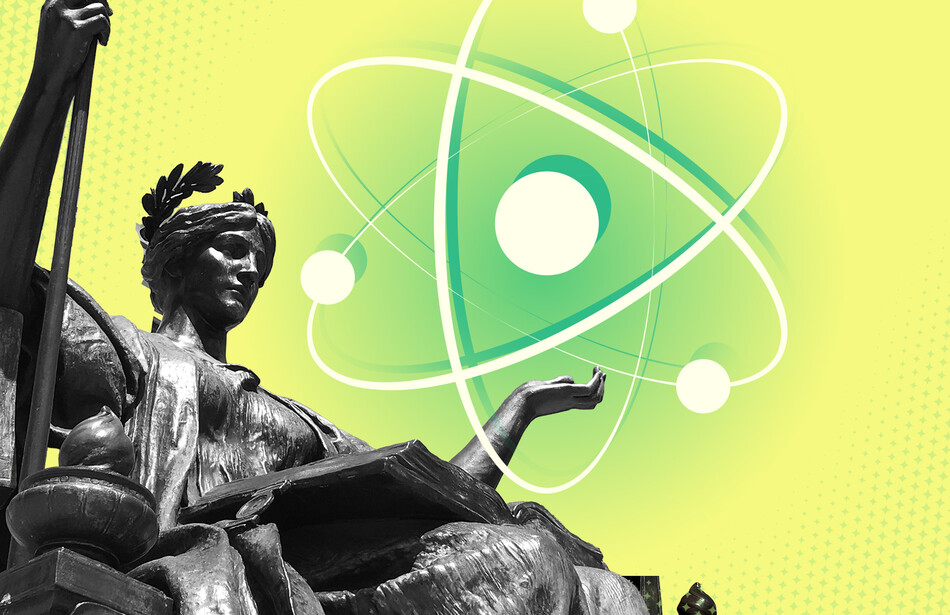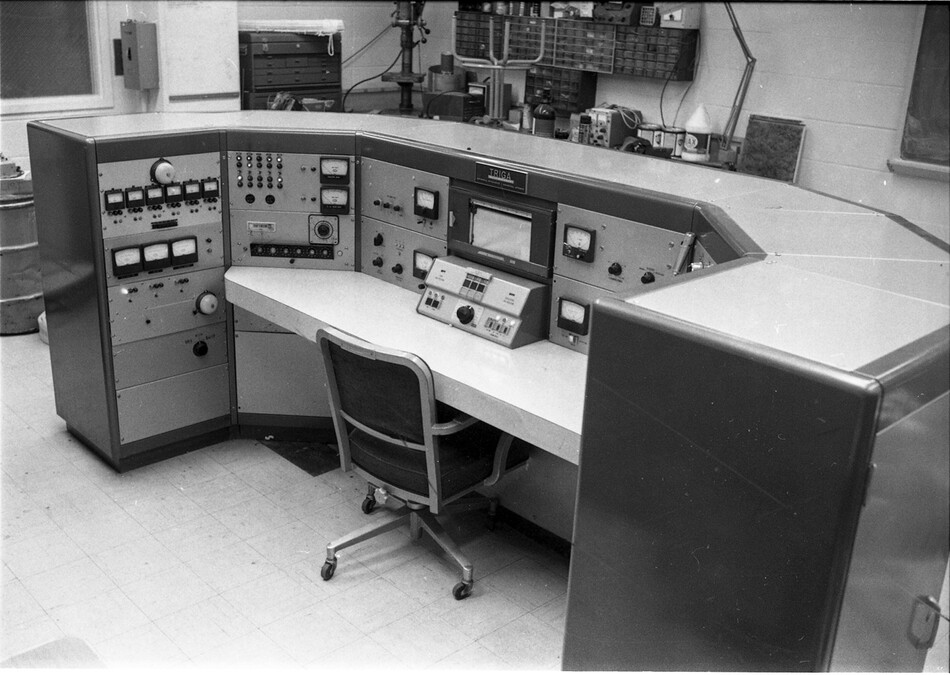Nukes are in the air again. Nuclear power, nuclear weapons, and nuclear anxiety. In the past month, Russia tested a nuclear-powered cruise missile, the US government furloughed workers tasked with safeguarding the country's nuclear-weapons stockpile, and Netflix released a new movie by director Kathryn Bigelow ’81SOA, House of Dynamite, which concerns a nuclear missile on its way to Chicago. And nuclear energy, once in the cultural doghouse, is also making a comeback, as smaller modular reactors (SRMs) are being planned in several states. All of which evokes a chapter in Columbia history when the University’s plans to build a small nuclear reactor on campus became a battleground of law, pedagogy, science, and public safety.
The case, like something out of Dickens, slogged on for twenty years. From 1959 to 1979, Columbia administrators, faculty, students, and neighbors, along with politicians, the Atomic Energy Board, the City Council, the Department of Health, and the US Supreme Court, wrangled over the fate of the modest reactor in the basement of the Seeley W. Mudd Building, home of the engineering school. The dispute lasted through three Columbia presidents, six US presidents, and countless meetings, panels, reports, hearings, and protests. And it ended, not with a bang, as many had feared, but with a meltdown a hundred miles away.
In the late 1950s, physicists Edward Teller, late of the Manhattan Project, and Freeman Dyson, a British physicist and mathematician, designed a prototype of a small nuclear research reactor. The device, called Training Research and Isotope Production Reactors General Atomic, or TRIGA, was intended as a research tool for universities: knowledge was power, especially during the Cold War, and the ability for students to split atoms right there on campus would give them a leg up in learning basic nuclear science.
At Columbia, faculty and administrators agreed that a small, low-energy reactor would be a boon for the physics and engineering programs, and in 1960, the National Science Foundation awarded Columbia $250,000 (nearly three million dollars today) to build a TRIGA reactor. But it wasn’t until 1963 — the year after the Cuban Missile Crisis terrified millions around the world — that the Atomic Energy Commission (AEC) granted the University permission to construct the reactor. Once the reactor was built, Columbia would have to apply to the AEC for an operating permit, and then, once approved, the uranium fuel could flow, and the neutrons could jump.
The proposed site for TRIGA was in the basement of the new Mudd Building at the southwest corner of 120th Street and Amsterdam Avenue. Columbia faculty, including physicist W.W. Havens 1914SEAS, director of the division of nuclear science and engineering; physicist Edward Melkonian ’40CC, ’49GSAS, director of the TRIGA project; and chemical engineer Charles Bonilla, ’29CC, ’30SEAS, ’33SEAS vouched for the reactor’s safety. They explained that TRIGA was a low-power reactor, capable of producing 250 kilowatts (enough power to run three thousand refrigerators), and equipped with a device that would shut the reactor down if it overheated.
To the professors, the research benefits — including the study of peacetime uses for nuclear fission and the production of radioactive isotopes that could be used in medicine — far outweighed the risks, which they saw as virtually nonexistent.
The reactor was completed in April 1967. It was contained within a thick-walled concrete chamber, with its core immersed in a twenty-foot-deep, aluminum-encased tank of water. But no sooner was the reactor built than the outcry began.
Seymour Melman ’49GSAS, a professor of industrial engineering and an outspoken proponent for nuclear disarmament, was one of four professors who argued that there was always the potential for an accident, that a nuclear reactor in a densely populated area posed an unacceptable risk, and that the community ought to be informed of the pros and cons. Local politicians echoed the professors, grassroots protest groups sprang up, and neighbors grew anxious about the idea of some sort of explosion or malfunction that would release radioactive material into the air.
In January 1968, the University applied to the AEC for a permit to operate the reactor. But another growing controversy in the community — the University’s proposal to build a private gymnasium in Morningside Park — made it a less than ideal time to fire up a nuclear reactor on Amsterdam Avenue. When tensions over the gym and the Vietnam War spiraled that spring into a student uprising, the administration, under President Grayson Kirk, asked the government to postpone its review of the TRIGA application.
That added another year to the project. Columbia reapplied to the AEC for the operating permit in November 1969 under its new president, William McGill. The AEC had never denied an operating permit after approving construction. After a decade of delays, Columbia was on the cusp of finally activating TRIGA.
But the storm of opposition had not passed. Student protesters showed up at the AEC hearing and later held a large protest in front of Low Library. At a meeting at Riverside Church, engineering professors Melkonian, Leon Lidofsky ’52GSAS, and Michael G. Woram ’73SEAS, ’74SEAS tried to assure the community that every precaution had been taken and that the reactor simply wasn’t capable of producing the kind of destruction that people imagined. Woram claimed that “the amount of radiation a person in the neighborhood could receive from the reactor is about the same as he would get from standing near five persons due to the naturally occurring radioactivity of the body.” Melkonian added that “I get more radiation dosage from chest X-rays than I would from the reactor.”
President McGill backed the engineering faculty, who, in his view, were on the correct side of a divide which pitted emotions and uninformed sentiment against scientific reason and academic freedom. But he was under pressure. In 1970, the City Council passed a resolution stating that the risks of the Columbia reactor “might be outweighed by a clear and pressing community benefit, but no such benefit exists. The reactor will serve only a few students who might be accommodated at existing reactors or at a reactor built outside a densely populated area.” The following year, the AEC, in a first, denied Columbia’s operating permit.
Columbia appealed the decision and won a reversal. Two community groups then appealed to the US Supreme Court, seeking to reverse the reversal. SCOTUS declined to hear the case — a victory for Columbia.
The problem was that it was 1975: New York was in a fiscal crisis, and the University was feeling its own pinch. It took money to operate a nuclear reactor, and the administration put TRIGA on hold. Meanwhile, thirty faculty members signed a petition opposing activation, which led McGill to write a response in which he stated that two Columbia committees found no “hard evidence whatever of dangers from radioactive waste products, polluted coolant water, or an improbable but nevertheless calamitous accident,” and that “to ban the reactor because of vague environmental arguments or because of community objections would be a violation of the academic freedom of the faculty and students.”
Finally, in 1976, the seventeenth year of the saga, the administration reapplied for the operating license. In 1977 the government granted it. There was one last hurdle: the city had recently passed an ordinance saying that anyone who wanted to build a nuclear reactor in New York City had to get the city’s permission. The fix was in: when the University applied for the permit, the New York City Board of Health denied the application. So Columbia, together with the federal government, sued the city, challenging its self-granted authority to supersede the federal government’s power to license nuclear reactors.
The matter reached a climax in December of 1978, when a federal judge in Manhattan ruled that the city did not have the authority to regulate the production of nuclear energy in New York. Columbia prevailed, and there were no more legal barriers left to activating TRIGA.
But McGill still faced staunch internal opposition from students and faculty, and it didn’t help when, in early March of 1979, Councilwoman Ruth Messinger wrote an op-ed in the Columbia Spectator, in which she argued that academic freedom “does not include the right to experiment with a nuclear reactor in a crowded urban area. No amount of protestation by the President of Columbia can obscure the evident and obvious differences between a professor’s right to say what she or he wishes in a classroom and a research scientist’s right to release into the atmosphere substances which have the potential to cause disease, death or unpredictable genetic damage.” For good measure, Messinger threw in the possibilities of sabotage and terrorism. But all of it would be rendered moot four weeks later.
On the morning of March 28, 1979, at the Three Mile Island nuclear plant near Harrisburg, Pennsylvania, a malfunction occurred in the water pumps in one of site’s reactors. This caused a complex chain reaction of mechanical and human errors, leading to a partial meltdown of the reactor core. Studies after the accident showed that the small amount of radiation released into the atmosphere was not enough to affect human health. But to many people, the incident was only more proof that the worst could happen. That a major disaster had been narrowly averted was not terribly reassuring.
McGill, seeing what he was up against, had retreated from his earlier, full-throated support for activation. Now Three Mile Island ended any further suspense.
Neither McGill nor his successor, Michael Sovern ’53CC, ’55LAW, who became president in 1980, were willing to disregard the widespread and passionate anti-nuclear feeling that followed Three Mile Island. Twenty years of legal and academic battles, which threatened to go on forever, were finally curtailed by the worst nuclear accident in US history.
Columbia’s TRIGA reactor, the concrete shell of which remains in Mudd, was never activated. That made it an anomaly. Back in the 1960s, other schools built and activated their TRIGA reactors, including Cornell, the University of Wisconsin, Penn State, UC Irvine, the University of Maryland, and Oregon State University. These and a dozen other TRIGA reactors are still in use today in the US, and no accidents have ever been reported.
In 1997, the year of his death, McGill gave an oral history interview for the American Institute of Physics. Recalling the TRIGA ordeal, McGill said, “What it did was to tear the University wide open, because a great deal of the opposition came from members of the philosophy, English, and humanities departments, which were perfectly prepared to shut down an activity in the physics department on phony environmental grounds, and would be aghast at any effort to suppress books. And the inconsistency of that position never seemed to get through to them . . . In the end I lost out because Three Mile Island went up at the moment that we won the legal fight.”
But for those who felt that any chance of a hazardous incident, however remote, was more trouble than the TRIGA reactor was worth, the events at Three Mile Island (and later, Chernobyl, Ground Zero on 9/11, and Fukushima) made the point for them, and have all but ensured a nuclear-free Manhattan in perpetuity.




